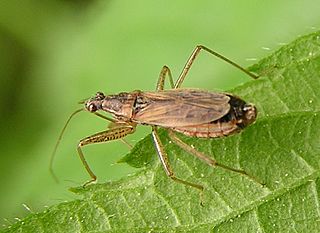
The insect family Nabidae contains the damsel bugs. There are over 500 species in 20 genera. They are soft-bodied, elongate, winged terrestrial predators. Many damsel bugs catch and hold prey with their forelegs, similar to mantids. They are considered helpful species in agriculture because of their predation on many types of crop pests.

Anthocoridae is a family of bugs, commonly called minute pirate bugs or flower bugs. Worldwide there are 500-600 species.

Cryptophagidae is a family of beetles with representatives found in all biogeographic realms. Members of this family are commonly called silken fungus beetles and both adults and larvae appear to feed exclusively on fungi although in a wide variety of habitats and situations, such as rotting wood and shed animal fur and feathers. These beetles vary from about 1 to 11 millimeters long, and usually have an oval body shape with a slight "waist".
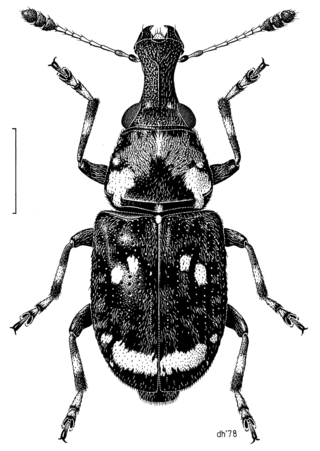
Anthribidae is a family of beetles also known as fungus weevils. The antennae are not elbowed, may occasionally be longer than the body and thread-like, and can be the longest of any members of Curculionoidea. As in the Nemonychidae, the labrum appears as a separate segment to the clypeus, and the maxillary palps are long and projecting.
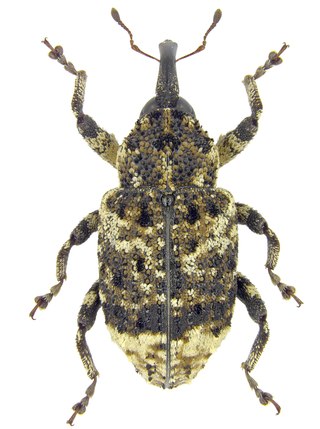
Cryptorhynchinae is a large subfamily of weevils (Curculionidae), with some 6000 species. They are found in most zoogeographic regions although they are most diverse in the Neotropics, Australia and Oceania.
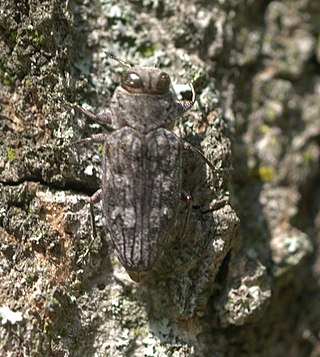
Chrysobothris is a genus of metallic wood-boring beetles in the family Buprestidae. There are at least 690 described species in Chrysobothris.

Periscelididae is a family of flies.

Monochamus scutellatus, commonly known as the white-spotted sawyer or spruce sawyer or spruce bug or a hair-eater, is a common wood-boring beetle found throughout North America. It is a species native to North America.

Valenzuela is a genus of psocoptera in the family Caeciliusidae, the lizard barklice. Some species are extinct and date to the Eocene of Poland or Russia. There are at least 300 described species in Valenzuela.
Coleothorpa axillaris is a species of case-bearing leaf beetle in the family Chrysomelidae. It is found in Central America and North America.
Cortodera subpilosa, the western mountain flower longhorn, is a species of flower long-horned beetle in the family Cerambycidae. It is found in the northwestern United States and southwestern Canada. Adults are dark brown to black, 7 to 13 mm in size, and are covered with fine hair.

Hypera is a genus of clover and alfalfa weevils in the beetle family Curculionidae. There are at least 280 described species in Hypera.
Acmaeodera alpina is a species of metallic wood-boring beetle in the family Buprestidae. It is found in North America, specifically in the western United States. Its adult host is Leptodactylon pungens. This species is more often collected and found on granite and bare soil than on flowers.
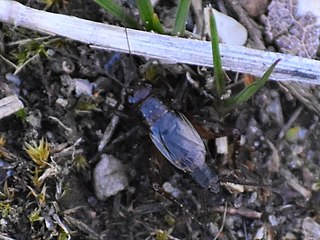
Neonemobius cubensis, the Cuban ground cricket, is a species of ground cricket in the family Gryllidae. It is found in the Caribbean. During its mating process the female will often feed upon the male’s glandular tibial spurs. Males who have mated previously will likely be found with some sort of damage done to their tibial spurs because of their mating process.

Trapezonotus arenarius is a species of dirt-colored seed bug in the family Rhyparochromidae. It is found in Africa, Europe and Northern Asia, North America, and Southern Asia.
Agrilus crataegi, the hawthorn agrilus, is a species of metallic wood-boring beetle in the family Buprestidae. It is found in North America.
Melanoplus payettei, or Payette's short-wing grasshopper, is a species of spur-throated grasshopper in the family Acrididae. It is found in North America.
Xanthonia furcata is a species of leaf beetle. It is found in North America. It is associated with wild cherry and oaks. The specific name comes from the Latin furca, meaning "fork".
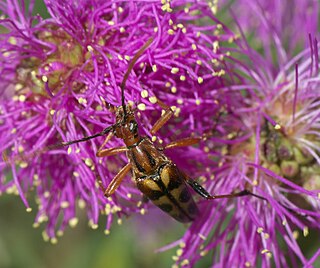
Strangalia luteicornis is a species of flower longhorn in the family of beetles known as Cerambycidae. It is found in North America. It has been observed mating on Hydrangea arborescens and Saururus cernuus, with the female consuming pollen from the latter plant.

Tetratoma tessellata is a species of polypore fungus beetle in the family Tetratomidae. It is found in North America.













